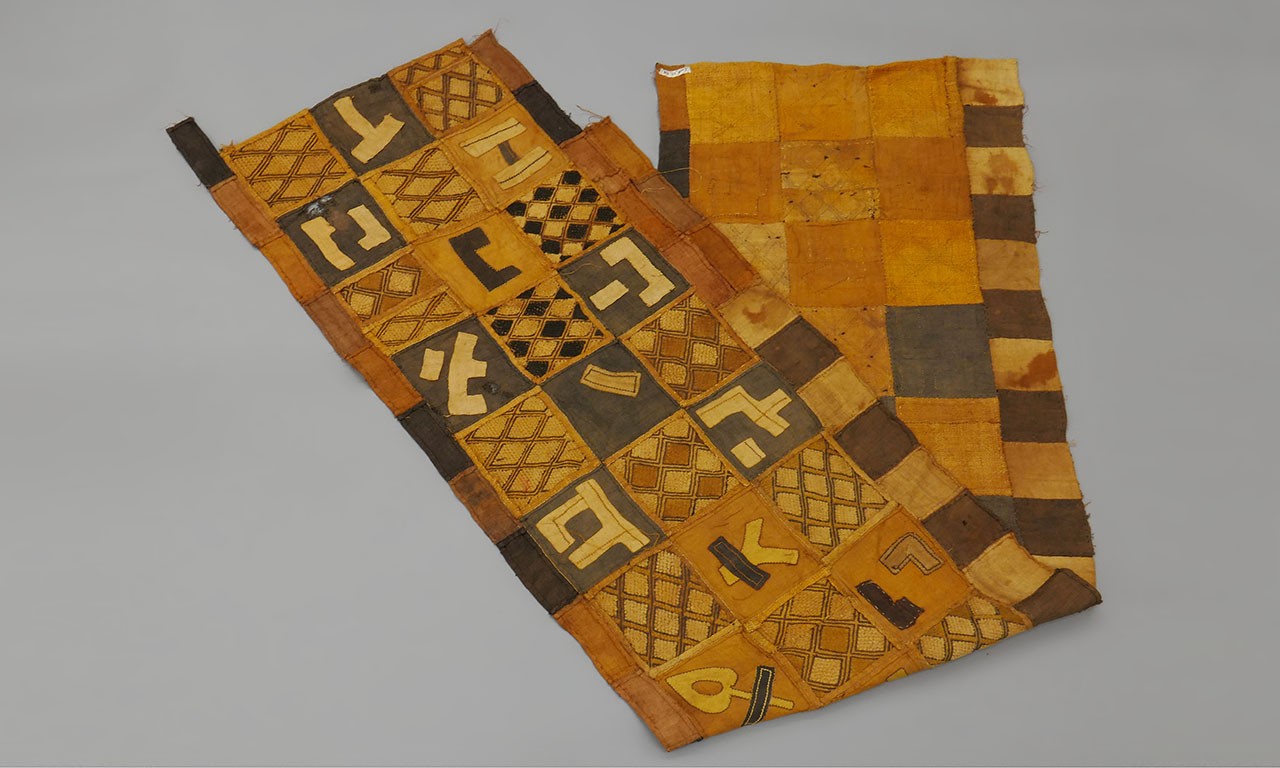2002 North Main Street
Santa Ana, California 92706
TEL: 714.567.3600
Modern Tradition: Nshak Skirts of the Kuba Culture
 |
| Skirts (Nshak), early to mid 20th Century Kuba culture; Kuba Kingdom, Democratic Republic of the Congo Raffia, cotton thread and pigment 2019.15.42,.44-.46 Gift of Anne and Long Shung Shih |
Human Tapestry
Donned by cultures across the globe, textiles of all kinds are a second skin, helping to define who we are as individuals. In English, one might say that they are “cut from the same cloth” as another, and that means that means that they have a shared nature. The Kuba culture of the Democratic Republic of the Congo refer to themselves, among other names, as Bambala, which originates from their word for a panel of woven raffia cloth. For “the people of the cloth” textiles are used as they are elsewhere to help define one’s status, as well as vehicles for expressing the independence and creativity of the artists who decorate them. This post looks at a group of five Kuba nshak women’s ceremonial dresses through the lens of their manufacture, design, and usage.

 |
| Skirt (Nshak), early to mid 20th Century Kuba culture; Kuba Kingdom, Democratic Republic of the Congo Raffia, cotton thread and pigment; 22 1/8 × 187 in. 2019.15.46 Gift of Anne and Long Shung Shih |
Raffia Lite
The production of the nshak is unique for several reasons. Around the world, most traditional textiles are made by women, fewer are made by men. In the Venn diagram of textiles made by different genders, nshak fall into the limited confluence of textiles made by both women and men. Usually, men begin the process with the cultivation of raffia palm. Another reason why these skirts are distinctive is that they are woven only from silky fibers extracted from the underside of the raffia palm rather than the relatively thicker fibers which are used for most textiles to come from the Democratic Republic of the Congo. Men are next responsible for weaving which is done on a loom. Though most men can weave to varying degrees of skill, the finest textiles are made by specialists. Because the Kuba do not join fibers together by tying or artificially, the size of most Kuba textiles is limited by the size of the palms from which they are harvested.

 |
| Skirt (Nshak), early to mid 20th Century Kuba culture; Kuba Kingdom, Democratic Republic of the Congo Raffia, cotton thread and pigment; 20 1/8 × 187 in. 2019.15.45 Gift of Anne and Long Shung Shih |
Appliquétions of Dyes
Women carry out much of the work from here. With finer textiles like the nshak they are responsible for wetting the cloth and then pounding it using a method that is not dissimilar to what is done with barkcloth. Smaller pieces of fabric which would become the designs were also prepared in this way to create multiple layers of relatively supple fabric. For the main body of the cloth, it would often retain the slightly off-white of the raffia fibers. For the pieces that needed to be colored, the next step was to dye them. Beige, red, black, and brown were primarily used but, as these textiles indicate, other hues like purple and lilac could be produced from local plants. When the main body of the skirts and the small bits of fabric which would become the appliqued designs had both been dyed, they were sewn together using needle and a black thread made in a similar way to the body of the cloth.

 |
| Skirt (Nshak), early to mid 20th Century Kuba culture; Kuba Kingdom, Democratic Republic of the Congo Raffia, cotton thread and pigment; 23 1/8 × 97 in. 2019.15.44 Gift of Anne and Long Shung Shih |
Ror-nshak Test
It was the design of the nshak that best offered a creative outlet for the women that created them. In general, the patterns of the Kuba are very geometrically inspired. Textiles can be broken down into larger rectangular and square plots. From there, squares, diamonds, triangles, T-shapes, interlocking weaves, and more become standard fare. Each of these shapes can be found on at least one of the Bowers’ textiles. The skirts are perhaps best-known for their vivacious and less easily defined forms. Whether these are purely abstracted forms or have antecedental origins which have been highly abstracted is debated. In looking closely at more complex nshak one can pick out shapes reminiscent of throwing knife currency as well as human, plant, and animal forms.

 |
| Skirt (Nshak), early to mid 20th Century Kuba culture; Kuba Kingdom, Democratic Republic of the Congo Raffia, cotton thread and pigment; 22 7/8 × 155 in. 2019.15.43 Gift of Anne and Long Shung Shih |
Worn Inspiration
Due in part to how complicated it was to create nshak, they became highly prized and their wear—exclusively by women as opposed to other men’s wrappings made by the Kuba—was reserved for ceremonial use. It was often the case that they were a betrothal gift woven for a bride by her husband-to-be and decorated by his female relatives. They might be worn for a wedding or any number of feasts that might be held by the royal family. In addition to their role as clothing, these textiles also served as one of the major inspirations for modernists artists like Matisse. It has been purported that he owned several nshak and hung them on the wall of his studio to inspire him. Keith Haring’s works also appear to draw from some of the more anthropomorphic patterns that appear on nshak.
Text and images may be under copyright. Please contact Collection Department for permission to use. References are available on request. Information subject to change upon further research.

Comments